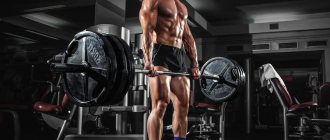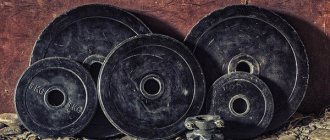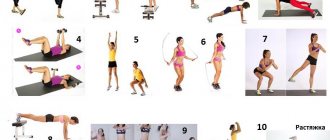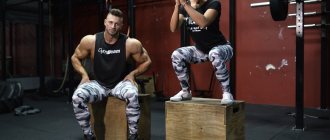German volume training is very hard, but thanks to such training, muscles grow quickly! Often referred to as the “ten set method,” this style of training will help you boost muscle growth.
Supersets and trisets allow you to perform a large amount of work in a short period of time. The rest-pause method allows you to use heavier weights to recruit fast-twitch muscle fibers, while eccentric training allows you to overcome strength plateaus.
The bottom line is that almost any training method will work as long as you train at a high intensity for at least the few weeks it takes for your body to adapt to it. However, there is one training system that stands above all others. It is extremely difficult, but it is a very effective way to gain muscle mass quickly!
In strength training circles, this method is often referred to as the 10-set method. Since it originates in German-speaking countries, it is usually called German volume training. It is also known that this training system originated in Germany in the mid-70s and was popularized by Rolf Feser, who was the national weightlifting coach at the time. A similar protocol was promoted by Vince Gironda in the US, but regardless of who came up with it, it works.
In Germany, the ten-set method was used in the off-season to help athletes gain lean body mass. It was so effective that within 12 weeks they regularly moved up an entire weight category.
This was the basic program of Canadian weightlifter Jacques Demers, silver medalist at the Los Angeles Olympics. Jacques was known in weightlifting circles for his massive thighs, and he credits the German method for achieving such impressive levels of hypertrophy. The same method was used by Bev Francis at the beginning of her bodybuilding career to gain muscle mass.
The program works because it targets a group of motor units by exposing them to a high volume of repetitive effort, specifically 10 sets of one exercise. The body adapts to extreme stress by hypertrophying target fibers. To say that this program quickly increases muscle mass is perhaps an understatement. An increase of 3-4 kg in six weeks is not uncommon, even among experienced athletes!
Warning
German volume training is only suitable for athletes with at least a year of serious training experience - at least 150 hours of training and a gain of at least 10 kilograms of pure muscle mass.
The athlete must have experience performing at least five sets of one exercise and experience performing sets of 10-20 repetitions.
If you are used to doing 3 sets per exercise or have always preferred to work on strength up to 5 repetitions per set, then German volume training will be a real shock for your body and especially for your heart.
I never tire of reminding my clients of the word “working in.” It is better to first slowly accustom your body to doing 10 approaches per exercise without taking into account time, and only then test your body in German volume training.
Have you ever tried doing 5 sets of 10 reps with a minute of rest? Do you know how to do exercises 20 times? For example, can you do 20 pull-ups?
If you can do 20 pull-ups, you can try German volume training.
Can you do more than 20 pull-ups? How long have you been training? Write a comment.
Create a training plan for a week for free
Training theory
Since time immemorial, there has been debate about what is better: lifting heavy weights for a small number of repetitions, or lifting moderate weights, but doing more work through additional exercises and approaches. Alas, there is still no clear answer to this question. Each person is individual; volume training may be suitable for one, and high-intensity training for another. Or it may happen that at a certain stage in the training process, a sharp change in methods will bear fruit. Let’s try to understand more specifically what high-intensity and volume training are.
The Birth of German Volume Training
German volume training has its roots in Germany. It began to be promoted by the German weightlifting coach Rolf Feder in the mid-70s of the twentieth century.
Legs are very important in weightlifting. And among his students, champions with big legs began to appear. Everyone began to ask why the legs were so big and Rolf began to tell how in the off-season he trains weightlifters to gain mass.
Which muscles are your priority in training and which ones are lagging behind in your body? Write a comment.
Coordination and neuromuscular conduction are important in the barbell. But it is better to develop coordination and conductivity with good muscle volumes. And Rolf discovered that increasing the volume of training leads to increased muscle size.
Create a training plan for a week for free
What makes muscles grow
A separate, large, theory-rich article will be devoted to the mechanisms of muscle growth - I hope to publish it on the website soon. For now, I will present these mechanisms in an extremely simplified manner. So, a muscle can grow due to:
- hypertrophy, which is a muscle response to ultra-high load;
- increasing the number of capillaries in the muscle;
- increasing the ability of muscles to store energy components (and not only), both inside and outside the cell. These components include: glycogen, creatine, fat, water;
- finally, muscle growth is also observed due to hyperplasia of muscle fibers, that is, an increase in their number (although the theory of hyperplasia has not yet been proven for people, the facts testify in its favor).
I repeat once again: this is a brief, extremely simplified presentation of the mechanisms of muscle growth; in fact, everything looks much more complicated. In this case, something else is important - whatever this mechanism is, its effectiveness largely depends on how many muscle fibers can be involved in the work. It is clear that the more fibers work during training, the more significant muscle growth will be.
Volume training in weightlifting
Typically, weightlifters do 5-8 sets of 3-4 repetitions in one exercise.
We always did 4 exercises, 8 sets of 3-4 repetitions. In total, we did about 100 lifts during the workout.
One day the coach came after talking with someone and said that now we will do an experiment. We started doing all the exercises in 5 sets and 10 lifts.
Four exercises of 50 lifts resulted in 200 lifts per workout instead of 100.
The weight of the weights decreased by 10-20%, but the volume increased by 100%. It was very difficult.
In addition, the pace of the approach has changed. Typically we would do a set of 3 lifts and rest for 3 minutes.
Now we rested between lifts for 10-30 seconds. The approach could take 5 minutes or more. There was also a crossfit tabata.
We did 5 sets of an exercise for 30 minutes and 4 such exercises per workout. Two hours of hard training 5 times a week. 10 hours of hell a week. This is extensive training. 1000 lifts per week with weight over 60 percent of the record.
Do you have any records in any exercises? Write a comment.
The table shows the entire weekly training volume. 20 exercises, 100 sets, 1000 lifts. And all with an intensity of 60-70% of the record.
Advantages and disadvantages of volumetric techniques
Such training is not a panacea. Like any other technique, they have advantages and disadvantages.
The main advantages include:
- Low injury rate
The chances of getting injured while doing such exercises are almost zero.
- Minimal stress on the central nervous system
This means that volume training is much less likely to lead to overtraining.
- Variety of exercises
This factor helps maintain a high level of motivation over a long period of time.
- A phenomenal feeling of pumping and filling your muscles with blood during training
Another plus for motivation. After all, it seems that the muscles grow directly during exercise. In the first weeks of using pump loads, there is a sharp increase in their volumes.
However, such schemes also have a number of disadvantages:
- Poorly stimulates muscle growth in beginners
For beginners, classic training methods aimed at developing fast muscle fibers are more suitable.
- Athletes claim that volumetric loads give unstable results
Often, after finishing classes using the pump method, the muscles are called “deflated.”
- Long and frequent training
As a rule, each muscle is worked 2-3 times a week. That is, you need to exercise 4-6 times every 7 days. Not everyone can devote that amount of time to sports.
And if you take into account the number of approaches, the workout can last for a long time, which is also not a plus for those who have other things to do besides the gym.
Even with a one-minute limit on rest breaks, the lesson requires 1.5-2 hours in the gym.
- Only work for a short period of time
Most techniques work for 3-4 weeks, after which there is a complete stop in muscle development.
- Doesn't promote strength gains
Of course, in bodybuilding, strength is not the main physical quality (especially at an advanced level).
However, among beginners and athletes of an average level of physical fitness, there is a close relationship between the increase in strength indicators and an increase in muscle volume.
The essence of German volume training in bodybuilding
The essence of NOT (German volume training) is simple - do 100 repetitions in one exercise. Typically this is 10 sets of 10 repetitions. The weight used is 60 percent of the rep max or whatever the athlete can lift 20 times in one set.
Note that 10 reps in a working set is half of the 20 rep max. Very similar to the half-hearted principle. What I mean is that home and backyard bodybuilders who train with their bodies can easily adopt the principles of German volumetric training.
If with the selected weight 60% of the record the athlete completed all 100 repetitions, then in the next workout you need to increase the weight of the weight.
How often do you add weight to your work? Write a comment.
The principle of 10 approaches or 100 repetitions is used in basic exercises: bench press, pull-ups and squats. All sorts of small exercises: biceps, abs or calves curls, are trained in three approaches.
Create a training plan for a week for free
NOT and cycles
Experts recommend doing volume training with micro or mesocycles. Rumor has it that someone in volume training gained 4-5 kilograms of pure muscle in just 2-3 weeks. (It is normal to gain 4-5 kilograms of muscle in one year in the second year of training)
After 2-3 weeks, experts do not recommend using German volume training, because they see no point in training if 2 kilograms of muscle do not grow per week.
Experts recommend alternating German volumetric training with abandoned training.
I don't recommend training too little. You can play with volume and intensity within thirty percent, but not three hundred. For example, volume training means training a muscle group once every five days, and a failed muscle group once every twenty. Training a muscle once every 3 weeks is too little, even if the intensity is very high.
How often do you train a muscle group and why? Write a comment.
Create a training plan for a week for free
SIZE MATTERS
Ask yourself a simple question: which organization can do more work: the auto repair shop in your neighborhood garages or the GAZ concern in Nizhny Novgorod? I think it is obvious to any reasonable person that, other things being equal, the larger the organization, the greater the amount of work it is able to perform, due to material reasons (more people, production capacity, resources, etc.). Is it so difficult to understand? Is it hard to believe that a car factory will always be able to fulfill a larger order than a car repair shop?
Now imagine that the auto repair shop workers begin to tell all their friends that the car cannot do anything and that in general their production facilities are “cardboard.” In general, they say, our auto repair shop in garages is power, and your auto plant with millions of orders and countless assembly shops is “all unreal.” I think any normal person, hearing such an example of nuclear criticism, will simply twirl his finger at his temple. But this will only happen if this person does not work in that small auto repair shop.
Have you already guessed where I brought this colorful example of human envy? This analogy shows how most ordinary people and athletes of other sports treat the large muscles of bodybuilders. They call them “inflated”, “cardboard” in order not to admit to themselves that large muscles are not decoration, but, first of all, an opportunity to do something that would be unrealistic for others.
WHAT BIG MUSCLES CAN DO
If we understand how large muscles differ in terms of functionality (not appearance) from athletic adaptations in other sports, then we will receive the key to proper training of large muscles. We will understand the essence of bodybuilding. For the “purity” of the conclusions, let’s compare related strength sports: BODYLIFTING, POWERLIFTING, CROSSFIT . In all of these sports, athletes train with barbells and weight machines. But the first one gets BIG MUSCLES , the second one gets STRENGTH , the third one gets ENDURANCE . Almost everyone knows this. And now, attention, we have already made the first mistake, which will destroy all our further reasoning, because it was made at the very beginning!
For the muscles of powerlifters and crossfitters, we “stuck” muscle QUALITIES (strength and endurance), and for the muscles of bodybuilders APPEARANCE (large muscles). All. It is pointless to compare further because it will occur on different planes. I tell him about Thomas, and he tells me about Yerema, as people of the older generation still say.
Let's fix this mistake and everything will fall into place. The bodybuilder is quite strong (muscles show power), but he lags behind the powerlifter in this parameter, who specializes in training power for one repetition. A bodybuilder is quite resilient , unlike a powerlifter, but he will not be able to compete in strength endurance on equal terms with a crossfitter who specializes in training this quality.
So what is the “power” of a bodybuilder’s big muscles? In versatility! Yes, he is weaker than a powerlifter, but not by much. Yes, endurance is worse than that of a crossfitter, but also not by much. A pure powerlifter will be significantly inferior to a CrossFitter in endurance, just as a pure CrossFitter will be significantly inferior to a powerlifter in strength power. But the bodybuilder will lose, but only a little, because he trains both STRENGTH and STRENGTH ENDURANCE at once!!! That's the power of big muscles! It is a fusion of strength and endurance.
BIG MUSCLES = STRENGTH + ENDURANCE
Personally, I call this muscle quality STRENGTH PERFORMANCE i.e. the ability of muscles to perform power work during k.l. time.
- STRENGTH PERFORMANCE is not pure endurance (like CrossFitters), because the weight on the equipment is higher and there are pauses for rest between sets (CrossFitters do it without rest).
- STRENGTH PERFORMANCE is not strength (like powerlifters) because the weight on the apparatus and the rest periods between sets are smaller (powerlifters rest a lot between sets)
Large muscles are a well-developed fusion of abilities such as strength and endurance, which results in monstrous STRENGTH PERFORMANCE . That's what big muscles are all about in terms of functionality, not appearance.
Large muscles allow the athlete to perform heavy strength work for a LONG time (for an hour), without severe fatigue . Big muscles are like a huge factory, with monstrous production capacity, which can fulfill an order for one unit (which many smaller organizations in your city can do), or can fulfill an order for a whole batch of units. Moreover, it will do it faster than anyone in your city, simply because its size and power allow it to do more work.
Do you really think that our body, which has been perfected for many hundreds of thousands of years of evolution, will do something without meaning? Don't overestimate your understanding of the issue! Nothing just happens . Large muscles are very unfavorable for our body because they absorb too much energy. The body goes to build big muscles only in those conditions when you need to do a LARGE VOLUME OF STRENGTH WORK! And nothing else, friends. Just pick up a calculator and calculate the total tonnage of kilograms lifted using a standard scheme for developing strength (powerlifting) and a scheme for developing muscles (bodybuilding).
You will see that even though the bodybuilder works with lighter weights, his total tonnage per workout will be significantly greater. For example, a lifter does 10 sets in 30 minutes (one set every 3 minutes) with a weight of 150 kg for 3-6 reps. And during the same time, a bodybuilder will do 20-30 approaches (resting less) with a weight of 100 kg for 6-12 times.
In fact, during a workout, a bodybuilder’s muscles perform a power volume of work that is 2-3 times greater than that of a pure powerlifter . And this is no coincidence, because it is precisely this kind of high-volume strength work that is best for growing large muscles.
The rule is very simple: MORE STRENGTH WORK = MORE MUSCLE
This is why in bodybuilding there are so many sets per workout and so little rest between them (usually about 1 minute). This strategy was developed experimentally among athletes in order to “fit” as much load as possible into the allotted training time.
And this is what fundamentally distinguishes large muscles from any other adaptations in our body. Big muscles do not equal maximum strength. Big muscles mean maximum strength performance. Those. the ability to perform strength work for a long time with minimal rest between sets.
HOW TO PUMP BIG MUSCLES
Now you understand that to do this you need to think not about the size, but about what this size gives. And it gives us ADAPTATION TO HIGH-VOLUME POWER LOAD!!! Train your muscles to do a lot of strength work and get bigger muscles.
Most successful bodybuilders work with heavy weights on equipment. For example, in the bench press it is usually 150-200 kg. But that's not the point (most successful lifters lift heavy weights in training). The point is that successful bodybuilders do a LOT of sets per muscle group per workout .
If you study the professional schemes of experienced bodybuilders, you will notice that there are many exercises and approaches in them. Thus, a bodybuilder lifts a monstrous amount of kilograms per workout. For example, for large muscle groups, experienced bodybuilders may have a total of 100-200 REPEATS per workout!!! Let's crunch the numbers... Let's say you do 8 reps per set. You have 4 such working approaches in the exercise. From one exercise we get 32 repetitions . How to do 100-200 repetitions? There are several ways to solve this problem:
- Do MORE REPS per set
- Do MORE APPROACHES per exercise
- Do MORE EXERCISES in your workout
Most often, experienced bodybuilders use the 3rd method (do more exercises), a little less often the 2nd method (do more approaches in the exercise), and almost never do the 1st method (increase the number of repetitions in the exercise itself).
And this is quite understandably justified. After all, in order to do more repetitions in the approach itself, you will have to reduce the weight in the exercise and then the load will be less forceful, i.e. It will be worse to grow muscles due to the departure from the optimal time spent under load. This is why most bodybuilders don't like to go beyond 6-12 reps. Not all though. For example, Kai Greene does significantly more repetitions per set, but he does them faster so as not to jump out in the required time under load.
But if you add more approaches to an exercise , then your total number of repetitions will immediately approach the desired range. For example, instead of 4 working approaches, you began to do 6!!! Then you get a total of 48 repetitions (it was 32). Therefore, among professionals there are athletes who do a lot of approaches to their favorite exercises. This allows them to develop the strength performance of their muscles more effectively.
Finally, the third, most popular way to increase the number of repetitions per workout. It's just adding more exercises . For example, you did 1 exercise for 4 sets, which gave you 32 reps. Now imagine that you are doing 4 exercises! This gives you 128 reps per workout! And this, frankly speaking, is a lot. This type of muscle stress is simply monstrous. It will either drive you into overtraining or force your muscles to adapt by increasing their volume.
ADAPTATION AND OVERTRAINING
And here we come to a very important point. It's no secret to most gym goers that professional bodybuilders' high-volume work regimens don't bring results in most cases. Why?
Because there are no physiological safeguards against human stupidity . If you have only swam in a paddling pool before, you should not try to swim across the English Channel right away. You'll just drown! But if you hear enough from homegrown “experts” that it’s “very simple” and “best for developing swimming skills,” you may decide that it’s right for you. The result will be disastrous because your body is not ready .
The same thing applies to volumetric training schemes. You need to increase the volume of loads for a very long time and slowly, so that your body and muscles HAVE TIME TO ADAPT (grow). If you do this all at once (quickly), your body will, in most cases, go into severe overtraining. You will have to forget about any muscle growth altogether for a long time, because you will undermine the capabilities of your body with too much load for it. Muscles grow as the load on them increases (PROGRESSION). There is an increase in load, which means there will be muscle growth. There is no increase in load, which means there will be no growth. Everything is fair. You can't fool nature. The load can be PROGRESSED in different ways:
- You can increase the WEIGHT ON THE BAR from workout to workout
- You can increase the AMOUNT OF WORK (do more approaches) during training
The first method is traditional and I recommend it to all beginners for a reason. The fact is that with this method of progression of loads, a green beginner will not be able to foolishly “tear the navel” of his recovery capabilities. Simply because he will not be able to DO MORE THAN HIS MUSCLES CAN NOW! Due to physiological “fuses”, he will not be able to lift more weight than he is given. He will be forced to increase the load very SLOWLY (1-2 kg per session), because the muscles simply cannot handle large increases in the exercise. And this is very wonderful, because it prevents you from making mistakes in terms of excessive load.
But the second method, which this material is about (increasing the volume of work during training), is more dangerous in terms of unbearable load, because the “safeties” are turned off. A guy can do as many sets as he wants his muscles to do. He can do 200 working reps if he wants. But even if he wants to, he won’t be able to bench press 150 kg. Do you see the difference?
I often see crazy people in the gym with an arm less than 40 cm who perform 20 or more working approaches for biceps. The training of these guys can sometimes last 2 hours, and they take their ingenious training “methods” from “experienced champions”. The logic is simple: if you want to be like a champion, then do what a champion does. Such people do not think that in order to perform high-volume training, the champion adapted his muscles for 10 years, and even with the help of steroids . That a champion would never have become one if in the beginning he had trained the way he trains now
CONCLUSION: You need to increase the volume of strength work during training for a very long time and in “portions” in order to give your muscles time to adapt (growth) . Do it differently and there will be no growth at all due to overtraining.
ABOUT THE TIME BETWEEN APPROACHES
You can often hear criticism of volume training on the grounds that it takes too much time and therefore does not work without steroids (the natural secretion of anabolic hormones is suppressed after 40-50 minutes of strength training).
Anyone who says this is not aware that a large amount of strength work can and should be packed into a short workout (up to 45 minutes). In order for this to become possible, it is enough to simply reduce the rest between approaches. Then over a certain period of time you will perform more approaches.
Bodybuilders often rest a lot (almost like powerlifters): 2-3 minutes. This is a mistake because such a long rest allows you to better develop strength power (strength), rather than strength performance . Remember, resting 60 seconds between sets will do much more for muscle growth than resting 2-3 minutes because it will allow you to do more strength work per workout. Most often, the time required to complete your exercise is 15 seconds . Some have a little more, some have a little less... According to my observations, even 45 seconds. There is more than enough rest to recover for the next approach. Of course, you will not be able to work with submaximal weights, because this requires a maximum reduction in acidification concentration and maximum restoration of energy levels. And this is possible with a long rest. BUT for working with moderately heavy weights, this rest is more than enough. I experimented on myself and will say that even 20-30 seconds is more than enough for rest.
Let's do the math. You do a set (15 seconds) and after that let you rest for another 45 seconds. As a result, the “full cycle” (approach + rest) is 60 seconds . What does it mean? This means that in half an hour you can do 30 working approaches!!! Just think about it...
Let's say you do 8 repetitions in a set, then 30 approaches will give us a total of 240 working repetitions! And this despite the fact that 100-200 repetitions per group per workout is already the level of a professional. Well, who would argue that it takes a lot of time to perform a large amount of strength work? This is all bullshit! If you came to work and not to wag your tongue, then even 30 minutes will be enough for you. Well, let you take the time to warm up. Even in heavy exercises (such as squats), rest a little more. All the same, it is not necessary to train for more than 45 minutes. And more than 60 minutes. just stupid. Especially if you are not using anabolic steroids.
Now about those same steroids. High volume regimens are often associated with anabolic steroids. They say, look, the big muscles of professionals are so big because they pump them up with a large volume of work along with the use of steroids. And this is a very big misconception.
In my latest book, “V3 Volumetric Progress,” I talk about very interesting experiments in this regard. Now I will try to summarize their essence. were conducted on amateur athletes who trained naturally according to different schemes . One group did only one working set of an exercise, while the other group did multiple working sets (i.e., trained in a higher-volume pattern). After a couple of months, measurements showed increases in strength and mass in both groups, BUT in the “high volume” group, this increase was significantly greater. And not so much in strength, but in mass!!!
Scientists analyzed the secretion of anabolic hormones during training and immediately after it in both groups and came to the conclusion that in the “high-volume” group this secretion was significantly greater . CONCLUSION: Several approaches to an exercise are better for increasing strength and especially mass than one approach! Those. High volume strength training regimens are better for muscle growth than low volume ones.
WHAT ABOUT MIKE MENTZER'S VIT?
Now you understand why the previous article was aimed at highlighting Mike Mentzer’s technique. The fact is that it is antagonistic to high-volume training concepts. Putting all the snot aside, we can safely conclude that low-volume training regimens (such as Mike Mentzer's HIT) will only work well for athletes using anabolic steroids . Because such training schemes stimulate the natural release of anabolic hormones much worse than high-volume schemes. Dot! Sorry, Mike. We'll discuss it when we meet.
CONCLUSIONS
The conclusions are very simple. Volume training is the best training concept for building big muscles . Just think for yourself: what is the fundamental difference between the training of a bodybuilder and a strongman or a weightlifter? A bodybuilder does the MOST sets in a workout (all those multiple exercises, sets, and reps) while training STRENGTH PERFORMANCE. And the consequence (external expression) of this adaptation is BIG MUSCLES! This is why a bodybuilder's muscles are larger than those of a lifter or crossfitter. Because big muscles are a fusion of strength power and strength endurance . And you can safely ignore what they tell you about the “fake” muscles of bodybuilders. Because if this is not done, then you will have to admit that the law of balance in nature does not work.
But you have to be very careful with progression along the volumetric path because power "fuses" don't work. Through greed, you can drive your body into severe overtraining. To prevent this from happening you need:
- Increase the VOLUME of strength work VERY SLOWLY and in “portions”
- Consider the REST TIME between approaches (use a watch for this)
- Stick to the plan and monitor the process with the help of a DIARY
Remember that volumetric progression of strength work in training is the most logical way from a muscle point of view to make them grow. BUT this method is the most dangerous because you will have to personally control this progression and rest time between approaches. Physiology will not help you (safeties are turned off). Everything will depend on your intelligence and planning.
Source: Denis Borisov
Split in German volume training
Experts believe that German volumetric training, unlike failure tripod training, is not highly intense - although the load is selected so that failure occurs within 100 repetitions - then, unlike failure training, one muscle group can rest not for 3 weeks after one workout, but only 5 days.
In general, failure in bodybuilding is a subjective term. Sometimes I use a heart rate monitor during strength training and it shows how much my muscles are burning. This adds objectivity to conversations about rejection.
What do you mean by refusal? Write a comment.
Russian Bear method by Pavel Tsatsouline
But it is not possible to understand the essence of this method from its name. And it is as follows: choose a weight with which you can do 6 repetitions with extreme tension. Perform a set of five repetitions with this weight. Rest for 3 minutes, reduce the weight by 10% and do another set of five reps. Rest for two minutes, then reduce the weight by another 10%. From this moment the torture begins.
Do sets of five repetitions, resting no more than one minute between them, until you can complete only 4 repetitions in the next set. This will be the signal to end the exercise.
This method is a truly unique development by a world-famous strength training specialist. Although it does not provide any gains in strength, it is possible to achieve quick and very significant increases in the volume of large muscle groups. The method was tested for accelerated development of the muscles of the legs and chest, but is also very suitable for “pumping” the back. As for small muscle groups, it is still difficult to say anything concrete.
A typical split in German volume training looks like this:
Day 1 chest, back Day 2 legs, abs Day 3 Rest Day 4 arms, deltoids, forearms, trapezius Day 5 Rest Day 6 The beginning of a new cycle.
Please note that the training cycle is five-day and is not tied to the days of the week, so supporters of German volume training should, if possible, avoid weekdays and weekends, work and family. You remember that our weightlifting training had rest days on days of the week, because everyone was studying, working and living with families.
Are your training plans tied to the days of the week? Write a comment.
Option #4 (Timo Neumann)
Your humble servant uses his own version of NOT in the training process. It is somewhat similar to the option proposed by Christian Thibodeau, but it also has significant differences. Firstly, I do not combine exercises into a combination set, and secondly, I only do one heavy exercise per muscle group. As for light (pumping) exercises, usually performed in simulators, there can be either one or two. Below is my version of NOTE using the example of training the chest and back muscles
| Exercise | Sets | Repetitions | Pace | Rest, with |
| Incline Barbell Press | 6 | 6 | 2010 | 90 |
| Crossovers lying on a reverse incline bench | 4 | 8 | 4020 | 30 |
| Hand raises in the butterfly simulator | 4 | 8 | 4020 | 30 |
| Parallel grip chest pull-ups | 6 | 6 | 2010 | 90 |
| Bent-over dumbbell row | 4 | 8 | 4020 | 30 |
| Lower pulley to the waist | 4 | 8 | 4020 | 30 |
In order to properly work all muscle groups, exercises can be changed from workout to workout. In “heavy” exercises, you can use a significant weight of weights - at the level of 75-80% of the one-time maximum. It is advisable to increase this weight from workout to workout. Weight in “light” exercises does not matter much - the main thing in this case is to maintain minimal intervals between sets.
Another option is to put a warm-up (muscle-stretching) exercise at the beginning of the program, and reduce the number of “pumping” sets by increasing the number of repetitions in them. For biceps, for example, it would look like this:
| Exercise | Sets | Repetitions | Pace | Rest, with |
| Alternating lifting of dumbbells on a bench with a backrest angle of 30 degrees | 2 | 8 | 4020 | 60 |
| Standing biceps curl | 6 | 6 | 2010 | 90 |
| Concentrated curls on the lower block | 3 | 16 | 4020 | 30 |
If we talk about muscle groups, the deltoids are the only one (besides the forearms and calves) that I do not load using the volumetric training method. My usual split for NOT is five days, but if I need to “tighten up” a lagging muscle group, I switch to an eight-day split, training the muscles lagging behind in development twice during the cycle.
That’s probably all I wanted to tell you today about German volumetric training. Try it - maybe this is exactly what you were missing. If something remains unclear, ask, I’m always happy to help you.
Variation of German volume training from Charles Poliquin
You see only two four exercises per workout and a total of 26 approaches.
Between super series you need to rest 90 seconds. 60 seconds between sets.
The pace of movement in the super series is 4-0-2-0. The weight is lowered for four seconds and the resting step (0 sec) is raised for 2 seconds. Then, without delay (0 sec), it lowers again.
In assist movements, the weight is lowered for 3 seconds instead of two.
Poliquin recommends training this way for 30 days – 6 cycles – 6 workouts. Next 100 repetitions is better to turn into 60 repetitions. And even better, change the exercises.
The second option according to Poliquin looks like this:
Also 4 exercises and 26 approaches. Rest is the same 60 and 90 seconds.
The pace of the exercises is very slow: 5-0-10-0 for basic exercises and 3-0-10-0 for auxiliary exercises.
The weight of the weight is selected so that the athlete can perform 12 repetitions in one approach.
Now you understand why sometimes big muscles are dumb muscles - slower muscles. To increase volume you need to slow down. Muscle volume can compete with muscle speed. This is important to know for those who want to be Bruce Lee and Schwarzenegger at the same time.











